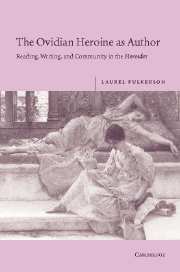Book contents
- Frontmatter
- Contents
- Acknowledgments
- List of abbreviations
- Introduction
- 1 Reading dangerously: Phyllis, Dido, Ariadne, and Medea
- 2 Reading the future?: Hypsipyle, Medea, and Oenone
- 3 Benefits of communal writing: Canace and Hypermestra
- 4 A feminine reading of epic: Briseis and Hermione
- 5 Reading magically: Deianira and Laodamia
- 6 Reading like a virgin: Phaedra and Ariadne
- 7 Caveat lector: thoughts on gender and power
- Appendix: The authenticity (and “authenticity”) of Heroides 15
- Bibliography
- Index
- Index Locorum
4 - A feminine reading of epic: Briseis and Hermione
Published online by Cambridge University Press: 22 September 2009
- Frontmatter
- Contents
- Acknowledgments
- List of abbreviations
- Introduction
- 1 Reading dangerously: Phyllis, Dido, Ariadne, and Medea
- 2 Reading the future?: Hypsipyle, Medea, and Oenone
- 3 Benefits of communal writing: Canace and Hypermestra
- 4 A feminine reading of epic: Briseis and Hermione
- 5 Reading magically: Deianira and Laodamia
- 6 Reading like a virgin: Phaedra and Ariadne
- 7 Caveat lector: thoughts on gender and power
- Appendix: The authenticity (and “authenticity”) of Heroides 15
- Bibliography
- Index
- Index Locorum
Summary
Previous chapters have introduced the paradigm of community as a useful tool to explain many of the aspects of the Heroides that critics have found difficult to understand; primary among them is the “repetitiveness” of the collection, which can now be seen as the result of the women's concentration on other stories, sometimes to the detriment of their own. Hermione, author of Heroides 8, is no different: this chapter suggests that she views Briseis as having usurped Hermione's own place in the family; Briseis' fashioning of herself as Helen is more credible (to Hermione) than Hermione's own relationship to her. The chapter will further demonstrate the contrast between traditional narratives (which can be seen as “male” ways of reading) and the heroines' construction of their own stories, given that Briseis, who is a minor character in Homer, will prove one of the most powerful models of the Heroides. In direct contradiction to the standard views of both women, Briseis will paint herself as vital to Greek success against the Trojans and Hermione (under her influence) will come to view herself as merely a prisoner of war rather than as the daughter of one of the most important Greek generals.
Reading Hermione's letter shows that she has constructed herself as inferior in every way to Achilles' concubine Briseis (author of Heroides 3).
- Type
- Chapter
- Information
- The Ovidian Heroine as AuthorReading, Writing, and Community in the Heroides, pp. 87 - 106Publisher: Cambridge University PressPrint publication year: 2005
- 1
- Cited by

